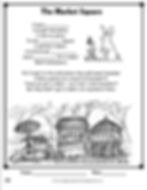
Dyslexia Games Workbook Samples
Learn More about the three series of Dyslexia Games:
These pages are from
Dyslexia Games Series A
For Ages 5 to 8




Theses pages are from
Dyslexia Games Series B
For Ages 8 to 12




How The Games Work

Did you know? Brain research shows that Non-Dyslexics use the left brain when reading. Brain scans reveal an absence of activity in the left brain when struggling dyslexics attempt to read. Research also shows that when a dyslexic person learns to read the brain activity is seen in the RIGHT SIDE of the brain, and not the left.
The right brain must learn to compensate for the absence of activity in the left brain.
SO, how does this information impact the way we teach dyslexic students? The right brain can be trained to read! But the right brain learns differently. Typical teaching methods fail with dyslexic learners. Yet most therapy for dyslexia calls just for more kindergarten (baby stuff!). This is wrong! To train the right brain to read we must use vivid 3D images, art, logic, creative thinking, and hands on techniques, Not childish phonics lessons!
Dyslexia Games is a fun therapy based on this research. The workbooks begin with ART, Puzzle Games and many 3D drawings. We know that dyslexic learners have a knack for figuring out these puzzles because of their visual thinking talents. The Puzzle Games activate the right brain and over time the games begin to introduce symbols, letters and numbers - as part of the art! The art and puzzles gradually transform into reading activities and over the course of 2 to 3 months, depending on the pace of the student, the right brain takes over the job of reading!
Eventually the student is weaned away from the art, as drawings are replaced with normal words, sentences and poetry. At the end of Dyslexia Games Series B the student is doing normal schoolwork. That can even read black letters on a white page. Once the therapy is complete the reading confusion is gone and students are able to move on to normal reading and writing activities!
Did you know that Dyslexics are brilliant and many will learn to read, with or without therapy? The natural process can take years! Dyslexia Games accelerates this process, empowering the student to overcome symptoms of dyslexia in a few months, not a few years! This is wonderful for a child's self-confidence!
Theses pages are from
Dyslexia Games Series C
For Ages 10+ Including Adults




Dyslexia Research References:
Horwitz B, Rumsey JM, Donahue BC (1998), Functional connectivity of the angular gyrus and dyslexia. Neurobiology: 95: 8939-8944. [Abstract]
Rumsey, JM, Horwitz, B, et al (1999): A functional lesion in developmental dyslexia: left angular gyral blood flow predicts severity. Brain and Language, 70: 187-204. [Abstract]
Shaywitz SE, Shaywitz BA, Fulbright R, et al (2003). Neural Systems for Compensation and Persistence: Young Adult Outcome of Childhood Reading Disability. Biological Psychiatry 54:25-33. [Abstract]
Updates — Recent Research
Hoeft F, McCandliss BD, Black JM, et al (2010). Neural systems predicting long-term outcome in dyslexia. PNAS, Published online before print December 20, 2010, doi: 10.1073/pnas.1008950108. [Abstract]
Leonard CM, Eckert MA (2008). Assymetry and Dyslexia. Dev Neuropsychol, 33(6): 663-681, doi: 10.1080/87565640802418597. [Abstract]
Welcome SE, Leonard CM, Chiarello C (2010). Alternate reading strategies and variable asymmetry of the planum temporale in adult resilient readers. Brain and Language, 113: 73-83. [Abstract]
Welcome SE, Chiarello C, Thompson PM, Sowell ER (2011).Reading Skill is Related to Individual Differences in Brain Structure in College Students. Human Brain Mapping 32 8):1194–1205. doi: 10.1002/hbm.21101. [Abstract]
See also: Can Reading Problems from Dyslexia be Prevented?, by Sharon Pfeiffer. The Dyslexic Reader (1994-1995).



